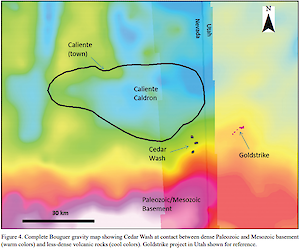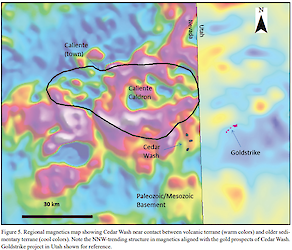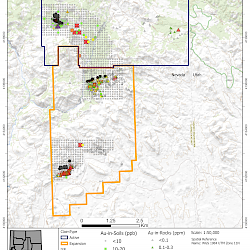-
Projects
Cedar Wash
The technical information contained on this page has been reviewed, verified, and approved by Derick Unger, CPG, VP Exploration of NevGold. Mr. Unger is a "Qualified Person" as defined by National Instrument 43-101, Standards of Disclosure for Mineral Projects.
Summary
One of Nevada’s newest gold discoveries, Cedar Wash is a project with truly “open in all directions” potential. The path to discovery began in 2015 when McEwen Mining began reconnaissance stage exploration in the area. Drilling by McEwen in 2017 proved the presence of a strong gold mineralizing system (16m @ 1.36 g Au/t and 10.7m @ 2.0 g Au/t) that closely resembles Liberty Gold’s nearby Goldstrike Project in Utah. NevGold will build on the early work completed by McEwen to aggressively explore this exciting gold discovery.
History
Nevgold’s Cedar Wash project is a high-potential, advanced exploration prospect located in Lincoln County, 75 kilometers southeast of Pioche, on the southern flank of the Clover Mountains.
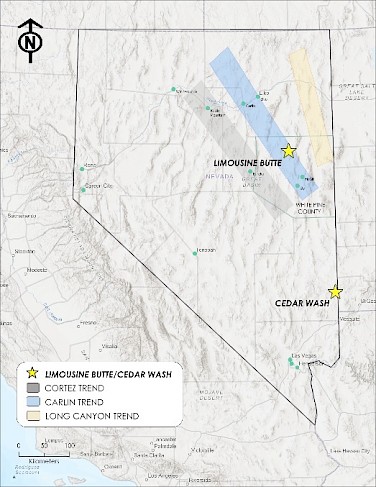
Nevgold acquired its 100% interest from McEwen Mining in June 2021. In 2015, McEwen had embarked on a reconnaissance program aimed at generating new projects.
Evidence of historical mineral exploration in the Clover Mountain area is limited to a few prospect pits and a dimension-stone quarry. An old iron and manganese prospect pit, hosted by Cambrian Bonanza King Dolomite, is located in the southern portion of the Cedar Wash area. A sample from this pit contains 31% Fe, 4.6% Mn and 200 ppm Ba, with no precious or base metal values, nor any Carlin-type pathfinder elements such as As, Sb, Hg or Tl.
Prior to 2015 there was no evidence of claim staking or mineral prospecting in the area of any of the mineralized outcrops in the project area. The concept of exploring for gold targets hosted in the Claron formation came from a curious occurrence of an altered, calcareous, Tertiary-age tuffaceous sedimentary rock with strong arsenic west of the Bristol district in Lincoln County. The Claron was reported as the host rock for the Goldstrike mine in Utah, located approximately 30km ENE of Cedar Wash, where 200,000 oz of gold were mined in the 1980’s. A program of regional stream-sediment sampling analyzed by bulk leach extractable gold (“BLEG”) was designed to sample drainages that flowed from areas of mapped Claron Formation in eastern Nevada.
Early BLEG sampling resulted in the project area a sample containing 0.003 ppm Au found draining a 3-square-kilometer area. Follow-up BLEG sampling led to the discovery of outcropping gold-bearing jasperoid in a bed of Claron limestone. Additional BLEG sampling in the region led to additional prospect areas with surface gold mineralization in windows of Claron, one of which is called The Narrows. Subsequent drilling found gold mineralization in all targets but the host rocks dip under thickening volcanic rocks that are variably altered and only locally mineralized with gold- and silver-bearing quartz-calcite veins. Strongest gold mineralization in drill holes is found at The Narrows target, along a WNW-trending window of Claron for a length of 335 meters, with an additional WNW-trending zone of gold- and silver-bearing veins and a corresponding gold-in-soil anomaly in overlying volcanic rocks extending for 2,000 meters.
Recent Exploration
More recent exploration was done by McEwen between 2015 and 2017. This consisted of mapping, rock and soil geochem, and some limited RC drilling. This work has identified a number of gold target areas with drilling yielding gold mineralization of economic significance (16m @ 1.36 g Au/t and 10.7m @ 2.0 g Au/t). Future work will focus on compilation of all McEwen data and targeting of additional exploration programs in high-potential areas where the Claron formation is known to exist.
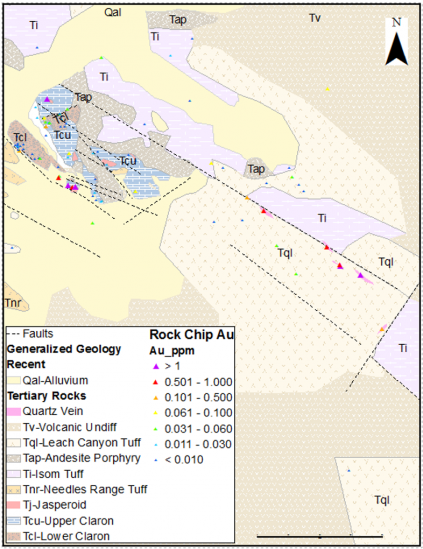
Geology
Cedar Wash lies 6–12 kilometers southeast of the Caliente Caldron boundary. Gold mineralization at Cedar Wash is hosted by the Claron Formation. Alteration associated with gold includes stratiform silicification, argillization, iron oxides and, locally, gypsum, where mineralization follows bedding. High-angle faults, trending north-northwest, west-northwest and east-northeast, locally control the shape of mineralized zones, and may have served as conduits for mineralizing fluids. Iron oxides, argillization and quartz-calcite veins have extended into the overlying volcanic rocks. Gold- and silver-bearing veins occur in The Narrows prospect. Gold soil data correlate strongly-to-moderately with Ag-Zn-Te-Sb-Hg-Tl-Se-Mo-As. This is similar to the geochemical signature of the Goldstrike Mine with the notable addition of Se at Cedar Wash. No intrusive rocks have been identified at Cedar Wash or the surrounding area. In the Goldstrike mining district in Utah, a Miocene granite porphyry laccolith is found at Mineral Mountain, which may have been a source for hydrothermal solutions for the gold deposits there.
Cedar Wash is located along a regional contact between Paleozoic and Mesozoic rocks to the south, with overlying Tertiary volcanic rocks to the north. The oldest rocks in the area are Cambrian dolomites mapped as Bonanza King Formation. To the east, in the nearby Goldstrike District in Utah, it is reported that southeast-directed regional tectonism of the Sevier orogenic event (160M to 50 M years ago) that placed deformed older Paleozoic rocks over younger Mesozoic rocks. East of Cedar Wash, at Square Top Mountain and Jackson Peak, geologic mapping found Paleozoic strata thrust over folded Mesozoic rocks. Subsequent erosion of the Paleozoic and Mesozoic rocks produced low topographic relief prior to deposition of lacustrine and fluvial sedimentation in early Tertiary time. These sediments comprise the Claron Formation, which consists of variable thicknesses of sandstone, conglomerate, limestone and tuff. The Claron was deposited on the erosional surface of exposed Paleozoic and Mesozoic sedimentary rocks. Cedar Wash is located near the western limit of the Claron depositional basin and is significantly thinner there than in the central part of the basin in Utah. The Claron Formation at Cedar Wash is variable and ranges in thickness from 25 meters to nearly 100 meters at The Narrows. It thickens to the east and appears to pinch out just west of the project area.
Geophysics
Regional gravity distinguishes between Tertiary volcanic rocks and the Paleozoic and Mesozoic older sedimentary rocks. The Claron Formation, forming the base of the Tertiary sequence, is located at the transition from higher-density Paleozoic and Mesozoic sedimentary rocks and lower density Tertiary volcanic rocks. The Caliente Caldron appears as a gravity low. Cedar Wash is located on a gradient between the volcanic center and the basement platform.
The regional magnetic map above shows magnetic highs associated with the volcanic rocks of the Caliente Caldron, contrasted with the lower magnetic sedimentary package. Cedar Wash lies at the southern edge of the volcanic field, along a regional NNW-trending feature in the magnetic data. The gold prospects at Cedar Wash are aligned with the magnetic feature, as are mineralized faults mapped in detail.
Mineralization
Two styles of gold mineralization are found at Cedar Wash: disseminated Carlin-style gold hosted by the Claron Formation, and gold-bearing quartz-calcite veins.
The Claron-hosted mineralization occurs in completely silicified, often brecciated, stratiform bodies, and in argillized sandy layers. Elements associated with the disseminated gold include Ag, As, Sb, Hg, Tl. The ratio of Au:Ag ranges from 0.4:1 to 0.005:1. The soft, often argillized Needles Range tuff directly overlies zones of mineralization, suggesting it may have helped to localize mineralizing fluids. Gold-bearing calcite veins were the focus of historical production at the Goldstrike district.
At Cedar Wash, quartz-calcite veins are found to contain gold at The Narrows prospect, where they are hosted by the Leach Canyon tuff. The veins follow northwest-trending high-angle faults that extend along strike from The Narrows Claron Window, up to 400 meters stratigraphically higher than the Carlin-style mineralization in the Claron.
Figures

Register to receive news via email from NevGold Corp.
* Required FieldsForm not found

